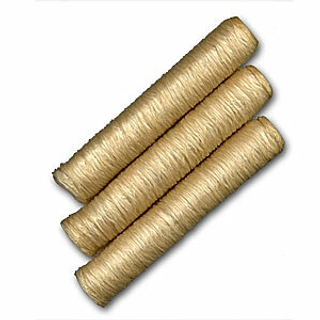Choosing the Right Sausage Casings
The sausage casing you select can greatly enhance your sausage making and eating experience. Sausage casings are available in various types and sizes. The four general categories of sausage casings are Natural Casings, Collagen Casings, Fibrous Casings, and Synthetic Casings.
Natural Casings (hog or sheep)
We prefer to use natural sausage casings for our sausage. A natural casing in our opinion gives the best flavor and appearance to the final sausage product. A natural sausage casing enhances and complements the natural juices and quality of the meat and spices. Natural cases permit deep smoke penetration if you are smoking your sausage.
Natural casings are made from the submucosa (a layer of loose connective tissue beneath a mucous membrane) a largely collagen layer of the intestine of hogs and sheep. Natural casings are are usually supplied in a sealed bag in a moist salt solution. Use what you need and then reseal in the provided resealable bag for storage. The resealed casings can be stored for months in the refrigerator.
For beginners, we generally recommend using hog casings to start with as they are easier to work with than the delicate sheep casings and produce a good thick sausage. Hog casings should be soaked in water for 30 minutes to an hour prior to using.
Sheep casings produce a very delicate thin sausage but care must be taken not to over-stuff them. Once you get the hang of sheep casings they are well worth the effort. Again, these casings should be soaked in water for 30 minutes to an hour before using.
Collagen Casings
 Collagen sausage casings are made from the gelatinous substance found in the connective tissue, bones and cartilage of all mammals. This is also the same substance used to make the famous gelatin dessert. Most commercially purchased sausage in the USA is stuffed into collagen casings.
Collagen sausage casings are made from the gelatinous substance found in the connective tissue, bones and cartilage of all mammals. This is also the same substance used to make the famous gelatin dessert. Most commercially purchased sausage in the USA is stuffed into collagen casings.
Collagen casings are the complete solution for all sausage applications, including freezing, deep fat frying, grilling and oven cooking. Collagen casings are supplied on a shirred stick and the amount needed for each application can be cut off. These casing are suitable for hand-linking provided the appropriate sausage mix and recipe are used. When hand-linking, the casing is dry, so we suggest using a vegetable oil to help with the process. Oil has the added benefits of leaving a lasting sheen on the sausage and helps with cooking. No soaking is required and they have an indefinite shelf life if stored in a cool dark place, refrigeration is not necessary.
Fibrous Casings
 Fibrous sausage casings are made from wood cellulose (essentially paper) permeated with protein. Fibrous casings are the toughest casings produced and are inedible.
Fibrous sausage casings are made from wood cellulose (essentially paper) permeated with protein. Fibrous casings are the toughest casings produced and are inedible.
What you would typically see with salami. They are used where maximum uniformity of the finished product diameter, whether sausage or smoked meat, is desired.
The uniformity of product stuffed in the casings make them ideal for slicing for prepackaging. These casings do not require refrigeration and should not be eaten.
Synthetic Casings
 Synthetic sausage casings are made from alginates, cellulose, and plastic. Don't worry, you should not eat this casing and it will not bleed into your product.
Synthetic sausage casings are made from alginates, cellulose, and plastic. Don't worry, you should not eat this casing and it will not bleed into your product.
The casings themselves require no refrigeration. Synthetic can also be known as artificial sausage casings.
Synthetic casings are used by mass producers and can be made in different colors or with different prints on them. They are the most uniform and strong of all types of casings. Synthetic casings should not be eaten.




